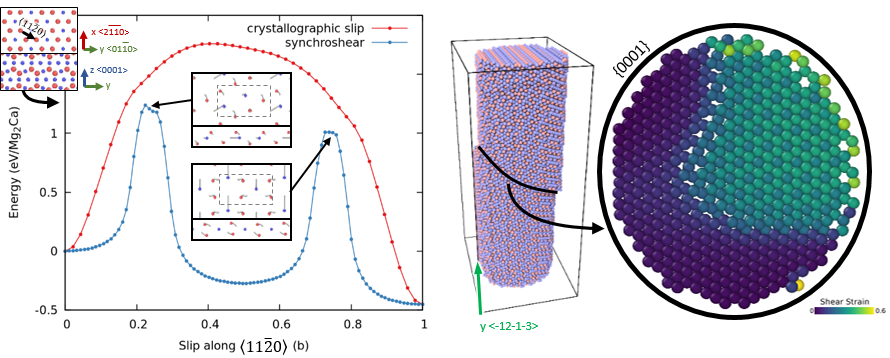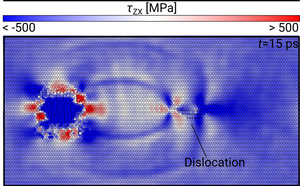Basal Slip in Laves Phases: the Synchroshear Dislocation
Two different mechanisms have been reported in previous ab initio studies to describe basal slip in complex intermetallic Laves phases: synchroshear and undulating slip. To date, no clear answer has been given on which is the energetically favourable mechanism and whether either of them could effectively propagate as a dislocation. Using classical atomistic simulations supported by ab initio calculations, we remove the ambiguity and shows that the two mechanisms are, in fact, identical. Furthermore, we establish synchroshear as the mechanism for propagating dislocations within the basal plane in Laves phases.

Fig. 1: Minimum energy path of the crystallographic shear and synchrosher in C14 Mg2Ca bulk Lave phase. Dislocation propagation in a C14 Mg2Ca nano-pillar by synchroshear mechanism.
[From Guénolé et al., Scripta Materialia, 2019][arXiv]
Basal Dislocations Interacting with Complex Precipitates in Mg Alloys
The mechanical properties of Mg-Al alloys are greatly influenced by the complex intermetallic phase Mg17Al12, which is the most dominant precipitate found in this alloy system. In this work, we perform atomistic studies of basal edge and 30 degrees dislocations interacting with Mg17Al12 precipitates of different sizes (D), shapes, orientations, and inter-precipitate spacing (L).
The present observations might be more generally relevant for dislocations interacting with semi- or incoherent precipitates.

Fig. 2: Stress field of a dislocation at the Mg-Mg17Al12 interface and in the Mg matrix.
[From Vaid, Guénolé et al., Materialia, 2019][arXiv]
